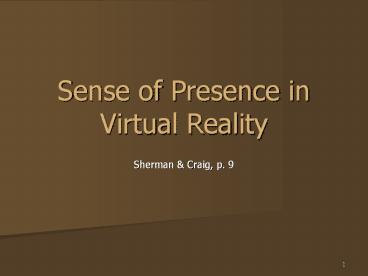Sense of Presence in Virtual Reality - PowerPoint PPT Presentation
Title:
Sense of Presence in Virtual Reality
Description:
Sense of Presence in Virtual Reality Sherman & Craig, p. 9 – PowerPoint PPT presentation
Number of Views:125
Avg rating:3.0/5.0
Title: Sense of Presence in Virtual Reality
1
Sense of Presence in Virtual Reality
- Sherman Craig, p. 9
2
Presence
- Sense of being physically present in a computer
generated or remote environment (Sheridan,
1992).
3
Immersion
- Physically immerse the participant in a
computer-generated space. - Provide computer-generated sensation to one or
more of the human senses.
Visual Auditory Olfactory Haptic Taste
4
Cued Gestalt
- We enter the virtual environment carrying the
baggage of our beliefs, experiences, fears and
expectations. - UVA (Pausch) Star Wars example
- Poor VR, no back story
- Poor VR, w/ back story much better
- What we bring to the VE is as important as what
we find there.
5
Virtual Elevator
6
Approximation
Being better than reality may be an option!
Recreating reality is not an option.
7
What creates a virtual experience?
Approximation
Cued Gestalt
- Immersion
Sense of Presence
8
Sense of Presence
- The perception of being in a particular space or
place.
- Attention
- Physical or emotional reactions to events in the
space. - Memories of events in the space.
9
Sense of Presence exists in spite of
- Cartoon environments
- Missing or incorrect sensory information
- Sensors that poorly match human capabilities
- Wires, gadgets and gizmos that the user must wear
10
Open Questions
- Is there a definition of presence that is
sufficiently operational and quantitative to be
useful? - What are the factors that create a sense of
presence? - Are there subjective and objective measures that
can quantify presence?
11
Open Questions (cont.)
- Are there applications for which a sense of
presence actually improves operator performance? - Are there applications for which presence is a
necessary ingredient? If so, how are these
applications different from applications for
which a more traditional display system is just
as effective?
12
Sheridan (1992)
Sensory Information
- Three measurable physical variables that
determine presence - extent of sensory information
- control of sensors relative to environment
- ability to modify physical environment.
Ability to Modify Environment
Control of Sensors
13
Zeltzers AIP Cube
- Autonomy - Ability to react to events and
stimuli. - Interaction - Degree of access to the parameters
or variables of an object - Presence - Number and fidelity of the sensory
input and output channels
VR
Autonomy
Presence
Interaction
14
How to measure Presence?
- Subjective measures
- Psychophysical measures
- Objective measures
15
Subjective measures
To what extent did you experience a sense of
being really there inside the virtual
environment? A little A lot 1 2 3 4 5 6 7
How realistic was your interaction with the
virtual objects? A little A
lot 1 2 3 4 5 6 7
16
Common Presence Questionnaires
- Witmer and Singer
- 30 questions
- Steed Usoh Slater
- 7 questions Likert scaled
- Neither are all that good, SUS slightly more
consistent - Should be used to compare similar environments,
not vastly different ones (like reality vs. HMD)
17
Psychophysical measures
- Generally, psychophysical techniques are used to
relate the physical magnitude of a stimulus with
the observers subjective rating of the stimulus
magnitude. - Example R f(S) where R is 1-7 feeling of
being present and S is a screen resolution or
lag time.
18
Objective measures
- Physiological measures
- Performance measures
19
Physiological measures
- Just as humans experience changes in
physiological parameters in response to novel or
unusual stimuli in the real world, given
sufficiently realistic stimuli in a virtual
environment, the human should experience similar
physiological changes. - Cardiovascular, Respiratory,
- Nervous, Sensory,
- Blood Chemistry
20
Wiederhold with Fear of Flying Patients in VR
Physiological measures Not Anxious
Anxious
Subjective Measures Not Anxious Anxious
21
Performance measures
- Behavior
- Suspension of belief
- Ducking
- Socially conditioned reactions
22
Example VE
- Design an experiment to test sense of presence
- Subjective
- SUS/WS after
- Behavioral
- cross chasm
- small steps
- curl toes
- Physiological
- heart rate
23
What increases presence?
- High quality visuals
- Low latency
- Head tracking
- Field of view
- Multiple senses
- Audio
- Haptics (passive if nothing else)
- Interactivity
- Avatar
24
What decreases presence?
- High latency
- Poor interactivity
- Disjoint Senses
- what you expect
- what you experience
- No Avatar
- Disembodied voice
- Cables
- Audio (people, lab, etc.)
- Called breaks in presence
25
What seems to be true?
- A person's experience of a situation in a virtual
environment may evoke the same reactions and
emotions as the experience of a similar
real-world situation. This may be true even when
the virtual environment does not accurately or
completely represent the real-world situation.
26
What seems to be true? (cont.)
- Each person brings their own Gestalt into a
virtual reality experience.
27
What seems to be true? (cont.)
- A primary difference between the experience of an
event in a virtual environment and the experience
of the same event in a real environment is in the
intensity or vigor of the experience.
28
What seems to be true? (cont.)
- A person's perceptions of real-world situations
and behavior in the real-world may be modified
based on his experiences within a virtual world.
29
What seems to be true? (cont.)
- Virtual reality is consequence-poor relative to
reality.
30
Presence?
Fidelity and attention to Sensory Channels
Gestalt
Consequences of Actions
31
Why is this important?
- Entertainment
- Training
- Education
- Therapy
- Pain control
- Rehabilitation
32
Groups studying presence
- Mel Slater University College London
- Effective Virtual Environments UNC































